
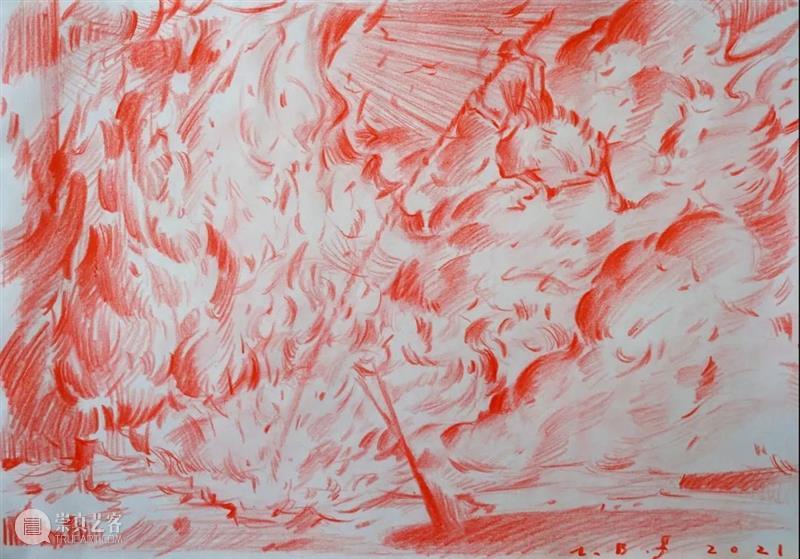
旷野上 On the wilderness
纸上红铅Red lead on paper, 2021
看哪,这火!
—论张博夫的绘画语言转向
文/姚斯青
在张博夫近年的作品中,画面的内容已经发生了难以忽视的变化。上一阶段曾刻意避免个人感受性的倾泻、代之以在相对封闭的画面空间里探寻结构性法则的手法——诸如在《芒室》、《真理屋》等展示的那种样貌——似乎正在成为过去式。人们四处看到了火,桔色与红色的巨大火堆成为了描绘的主体,其光照范围却不大,在幽暗的背景之上跳动着;而另一面,火也变形为占领了视网膜的树丛,绿意涌动。在火与树的变奏中,我们看见它们互换了质感:火因其硬朗的轮廓线而凝固化,这强化了它不熄不灭的特征;而树则像丛生的柔软火舌,被风吞吐着、斜向上生长,火的形质反倒赋予树一种炽盛的无限可能。
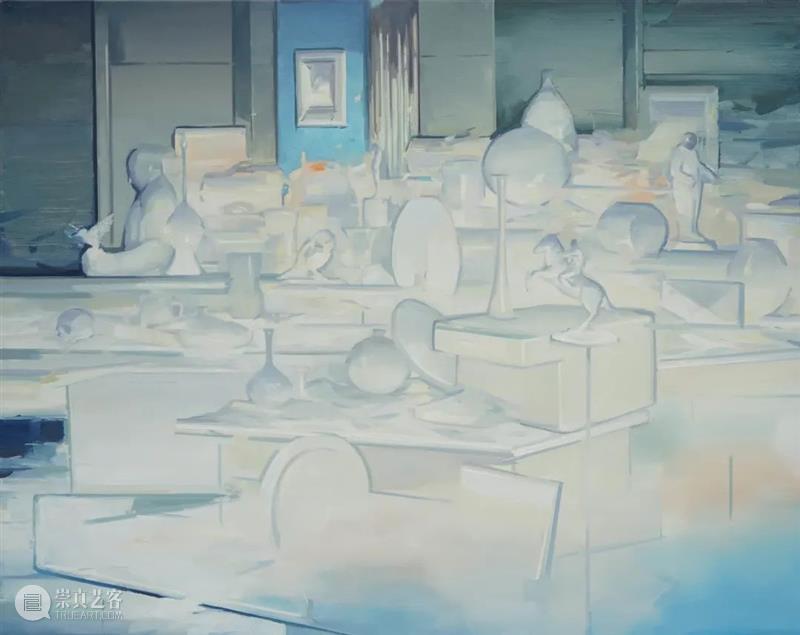
芒室 Glowing Hous
布面油画 Oil on Canvas, 210x170cm, 2016
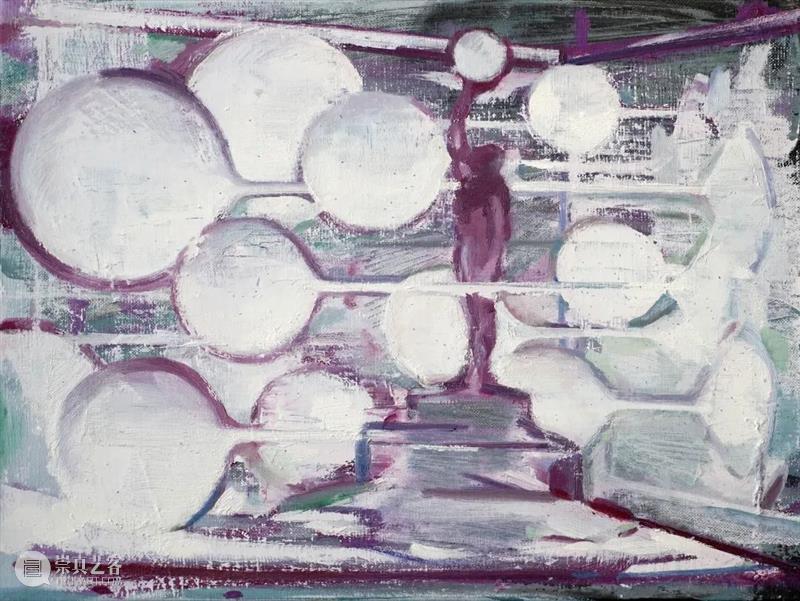
关于真理的选择(真理屋)stay in truth(house of truth)
布面油画 Oil on Canvas, 40x30cm, 2016
火一跃而出,成为了张博夫画面中最主要的象征物。这无疑不仅仅是画面内容的变化,也是表达方式的变化;趋于象征,意味着画家正尝试用另一种语言对观众说话,因为此前有意回避个人性的语法已经失效。画火变成张博夫无可回避的内在需要,根本原因在于死亡的撞击指引他对生命的存在与价值进行叩问。所以,这系列近作,也被艺术家自己称作是更具有“返身性”的绘画,是列维纳斯所言的“逆死而在”的体验。然而,这一种个人经验化的诠解方式,仍无法充分解答,这火何必是象征的?为何它不是表现抑或写实的?它是对过去的自我反叛抑或转进?或许,解答问题的线索仍在画中,这就要求观者进一步凝视这火。
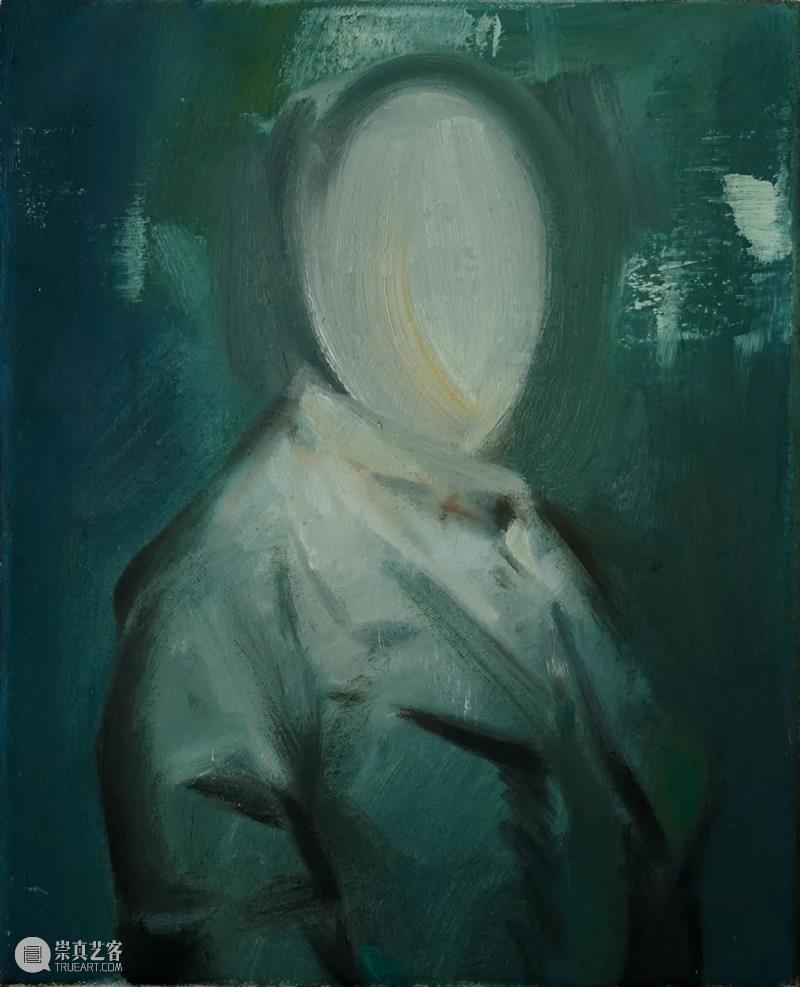
自明 Spontaneous Light
布面油画Oil on Canvas,30x24cm , 2018
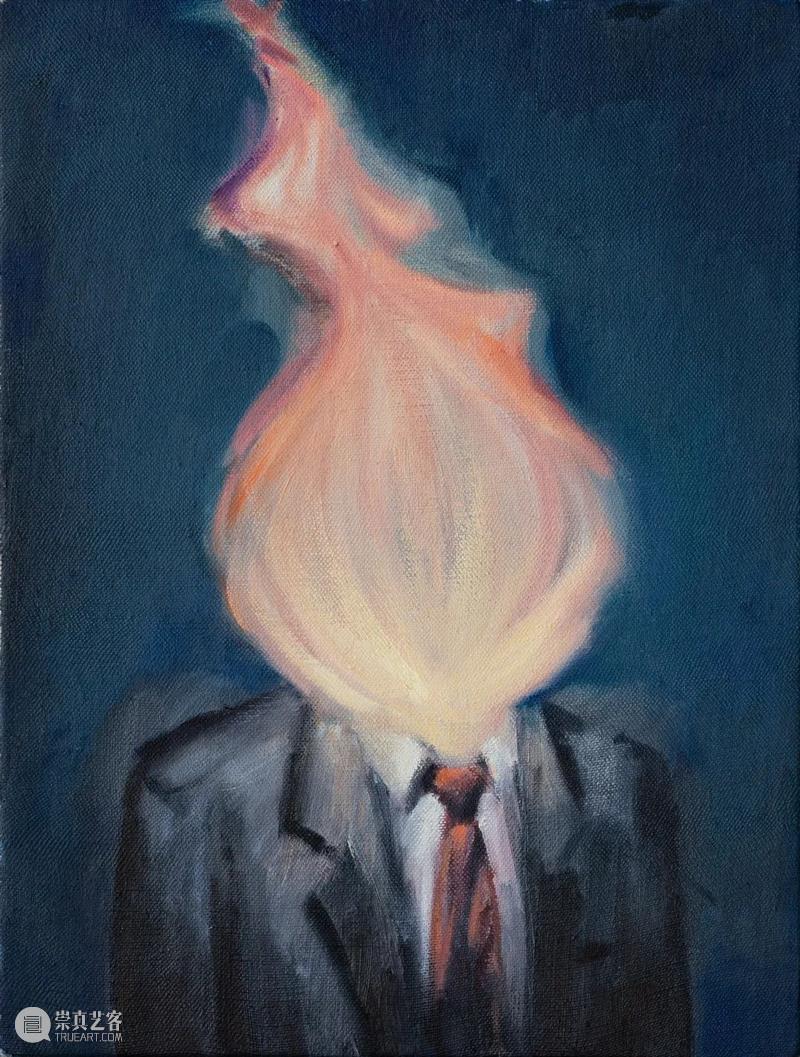
世界 The World
布面油画Oil on Canvas ,40x30cm, 2019
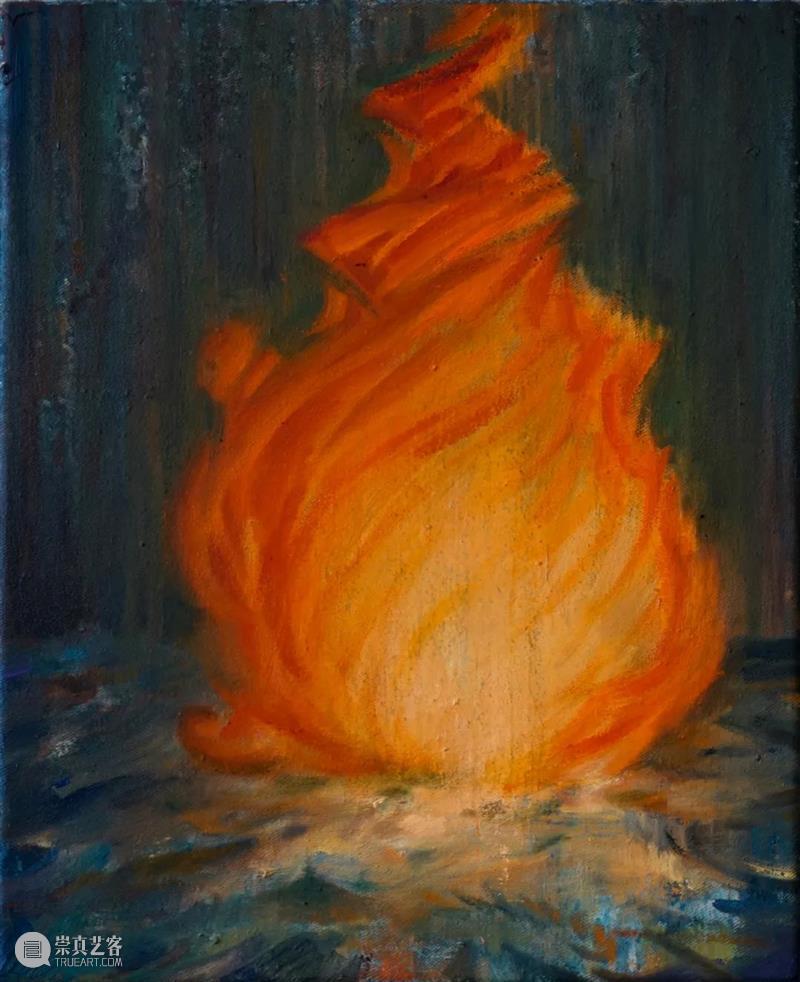
雨夜不灭的火焰unquenchable in the rainy nights
布面油画Oil on Canvas,30x24cm, 2019
我们从中看到的是怎样的火呢?西装革履者被命名为《世界》,他的头部是火,他的面容被隐藏,这依稀能看出张博夫此前作品的影子——他执着于绘制一种匿名的、反肖像的人物精神切片,在抹去了个体化的经验痕迹后,只留下身处庞大社会集合中的模糊定位与既定动作,例如那位丧失了头部的《塑形者》,更甚者则只留下了盲动的腿部,如《无帆支桨》。此外还有雨夜的潮湿也无法熄灭的火堆,它螺旋上升着,执拗指向上空,照亮了前景的一小块地面,而其背后仍是一片幽暗,为幕布所遮挡。这一背景的设置使它和另一幅画作《幕帘》具有了相关性。
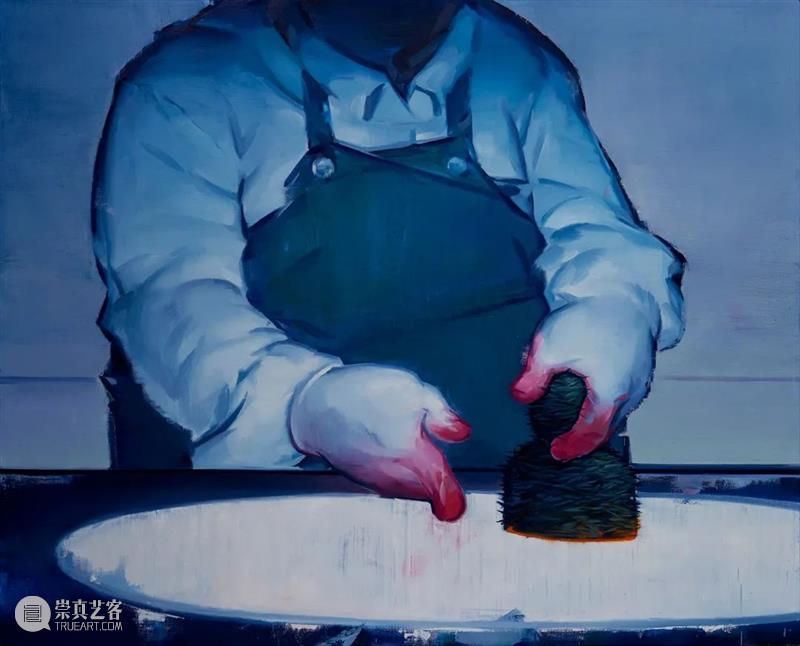
塑形者Shape Maker
布面油画Oil on Canvas, 210x170cm, 2016
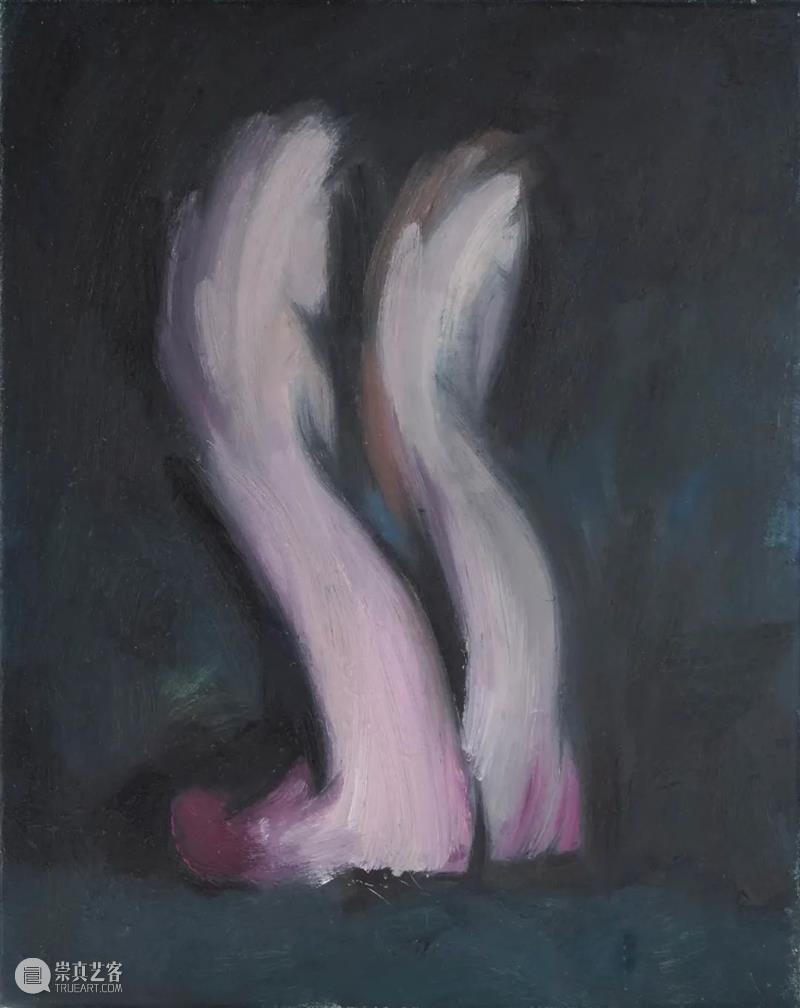
无帆支桨No Sheet for Paddling
布面油画Oil on Canvas, 30x24cm, 2018
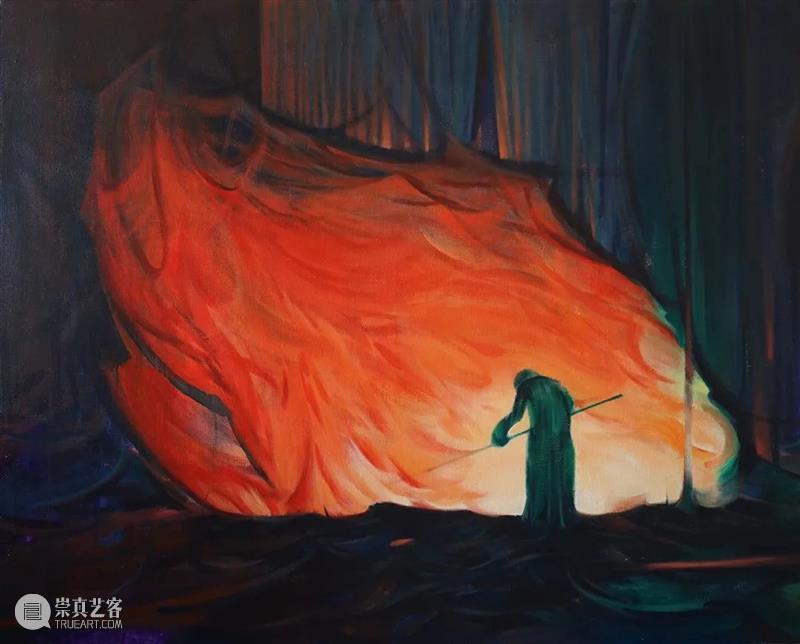
幕帘A Close
布面丙烯Acryilc on Canvas,190x150cm, 2020
《幕帘》是张博夫这一阶段最重要的作品之一,它也最为全面地转译出艺术家对生命与世界的所思所感。在《幕帘》中,火堆在舞台上燃烧,甚至长出了坚硬的棱角,幕布只微微掀开一道缝隙,对台前的观众保持着神秘。戏还未上演,即舞台与日常尚未连成一片,而我们画外的观众却被画家置于后台,因为这一特殊的视角,被赋予了提前窥探的特权:在个体生命诞生之前,在无常际遇与自我意识开展之前,那只是一团雄雄火焰,一位身着绿袍的助燃者背对我们,手持长杖翻动火堆,使其气息流动而不至于熄灭……幕帘即将被拉开。当艺术家意欲通过视觉图式对生命源初这一先验知识予以说明,它就只能呈现为象征的手段。在画中,火坚实有力的造型,似乎进一步映射出艺术家不欲其受外部环境影响而熄灭的意欲,同时也审慎地控制着火不四处蔓延而造成危害,必须注意到:张博夫赋予火的这两个特征恰好与一切经验之火背道而驰。随着时间流逝必将消逝或扩散的经验之火,被摒除在画中世界之外;至此,我们对象征之火的凝视方有了第一重回味。
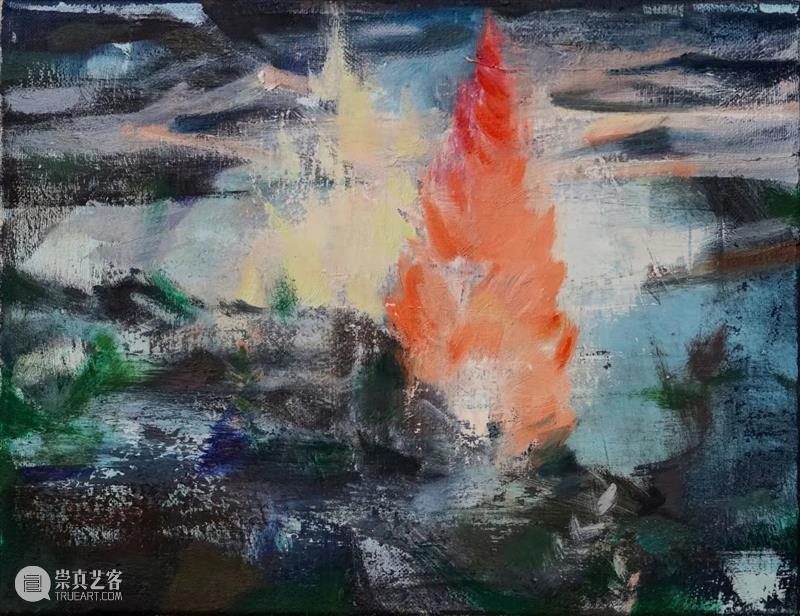
两丛Tow clusters
布面油画Oil on Canvas, 30x24cm, 2019
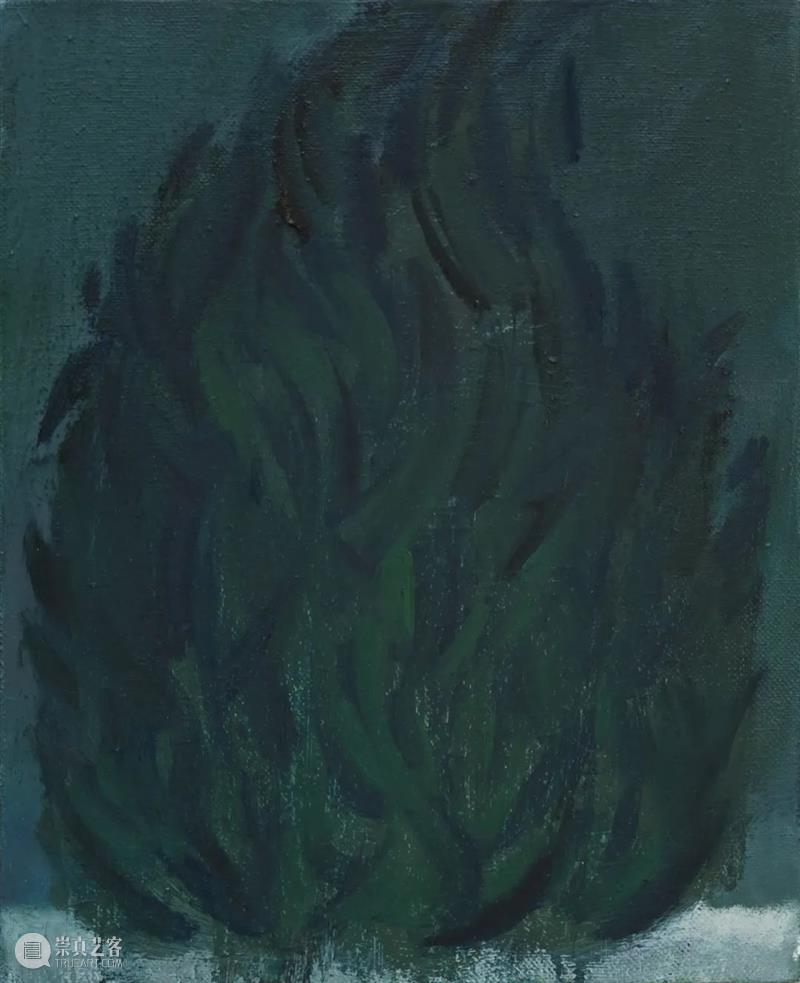
小树 Sapling
布面油画Oil on Canvas, 22x27cm, 2020
象征主义作为理想主义的一种简化图式,其典型特征正好是要寻找超出自然时间之上的世界,这也就意味着使火坚卓。召唤历史上我们熟知的种种火之图式,首先跃出脑海的可能是被赫拉克利特作为世界本原的火、五行相生相克中的火、祆教之火……篝火、火炬、烛火,一切宣称驱散了黑暗和蒙昧的启蒙之光映衬在人类益发文明的眼眸中,被描画为可欲且可控的,象征主义改写了火的双重性,抹去它尼禄焚城时的狂暴,除去将之赋予正面的道德意涵,也使得它的负面意义被清洗、滤净为单纯的能量与生机。于是,火得以被放置在世界开始之前的位置,作为支撑其运转的基本元素。在张博夫笔下,同样能发现上述这种对“火”重新编码的意志,画中的助燃者形象乃是表征对作为本源的火的看顾,一种专注的人类视线被人格化,这在其他画面中也存在着;并且,在《两丛》、《新树》、《团树》《崖柏》及《自由树》等表达中,他进一步通过将“火”转换为植根于大地之上的“树”来强调对葆有其光的汲汲热望。看到此处,张博夫笔下之火才拥有了第二重回味。
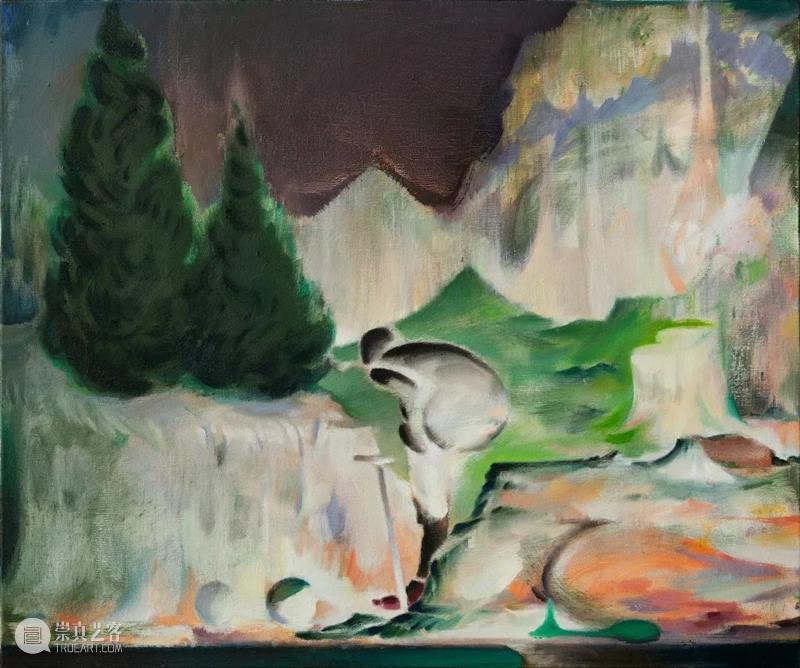
新树New Tree
布面油画Oil on Canvas, 60x50cm, 2020
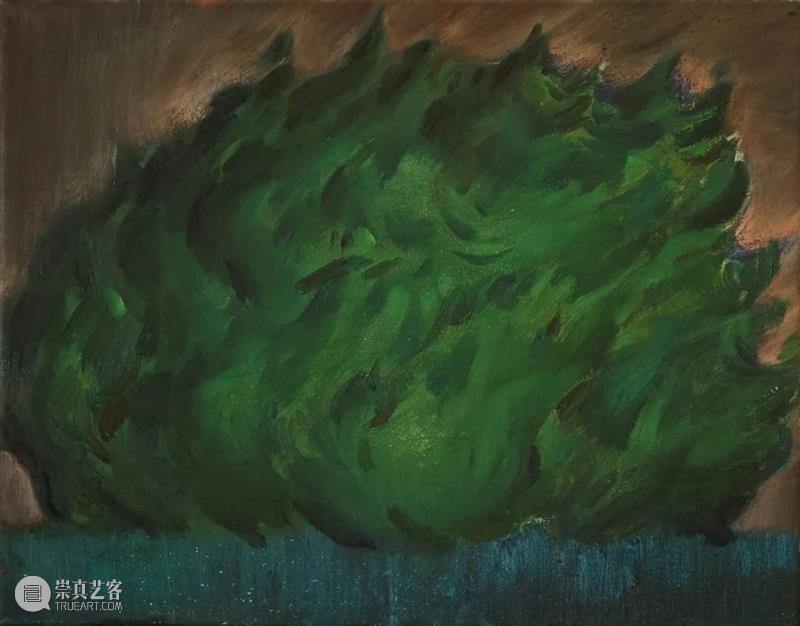
团树Round Tree
布面油画Oil on Canvas, 30x24cm, 2019
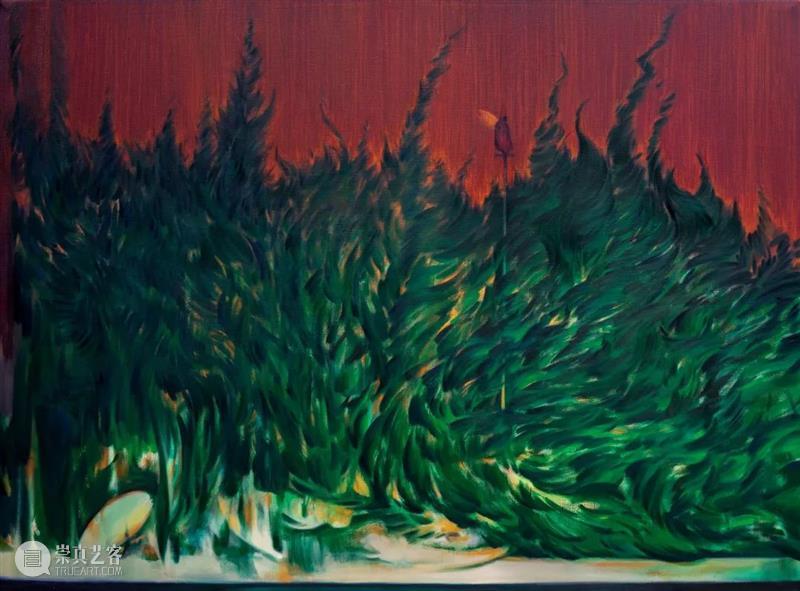
崖柏Cliff Cypress
布面油画Oil on Canvas, 200x150cm, 2020
从“火”到“树”的变形,“火”向固态的转化,“火”获得了持续生长的契机,同时也可以看出张博夫有意将先验的原初能量向经验世界渗透,从而透露出一种对生机的执着之感。这与《幕帘》中的“幕帘”隔开了有死之生与有生之前,是能相互呼应的。在这些绘制了树的画中,张博夫曾经在德国黑森林中漫步的记忆是否被唤起是难以揣测的,但画面的执着于“生”,则确实与其思想意识有更深入的关系:人的有死性在这一时期成为张博夫萦绕不去的思考核心。从彼岸的边缘回望此岸,由人的有死性而发展出的对“如何活着”的困惑,曾是古典哲学中的“大哉问”,柏拉图的《斐多篇》即是探讨这一问题的著名文本,相信灵魂不灭从而安然就死的苏格拉底展演了灵肉二元的巨大张力……而在更为私人化的语境中,张博夫最终吸纳列维纳斯式的“逆死而在”,列维纳斯以“享用”来理解生活中个体与他者之间的关系,其实也就在有死的阴影下提出了积极的伦理生活面向,从而将个体的生存视为具有反身性的一系列律动。明晰了这段心路历程,首先有助于我们去理解张博夫在绘画理念上的转变:以往的他将绘画视为不以自我为目的行动,是一种不回应主体自身需求的客观存在,甚至认为对个体经验的强调是实践理性上的缺乏自律;但这种看法现在已经为“逆死而在” 的真切需求所改变,因而使绘画语言发生了转变。
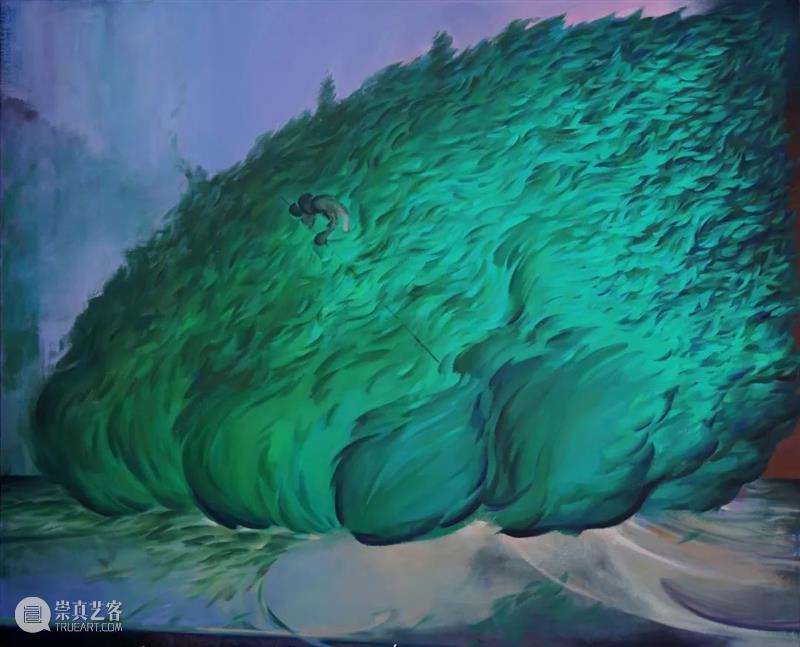
自由树 Free Tree
布面油画Oil on Canvas, 210x170cm, 2020
这也迫使我们更进一步去理解画中“助燃者”的存在,尤其是它所表征的伦理性的诉求到底为何。除了《帘幕》之外,同样的角色也出现在《自由树》中,且其形象变为更为隐而不彰、像浮于树丛中的一团幽灵,手中纤长的拨火棍也恍惚变成了操舟之桨,其功用在助燃与借力间,更为混杂暧昧。不难注意到,在《荒诞之海 桅杆之上》与《时节》中,这位助燃者几乎就化身为海波上的舟子了,脚下的水既能渡他亦能覆他,主体与他者的关系在此处紧张地相互交织,不是绝对的对立,也不是绝对的交织;但也正是通过这样的方式,主体从一种功能性的位置上脱落,从《塑形者》的机械动作中脱落,从《世界》中的西装所表征的社会之网中脱落,得以言说存在的体验,在死之无常与生之搏战的永恒张力中,一刻不停地拨动着。看哪,这火!在“火”与“树”的变奏中,张博夫为我们延展开一再回味“火”之意象的契机;而几经回旋,我们最终发现,这火中奇异的助燃者,与其说是张博夫眷恋于火/树的生机,不如说他执着于通过助燃者的形象来重塑“我”与“火”之间的伦理关系,这最终又超越了对“火”之象征图式的简单表达。也许,在张博夫这回强烈的象征式冲动下,也已经蕴藏着另一次绘画语言转向的可能性了。
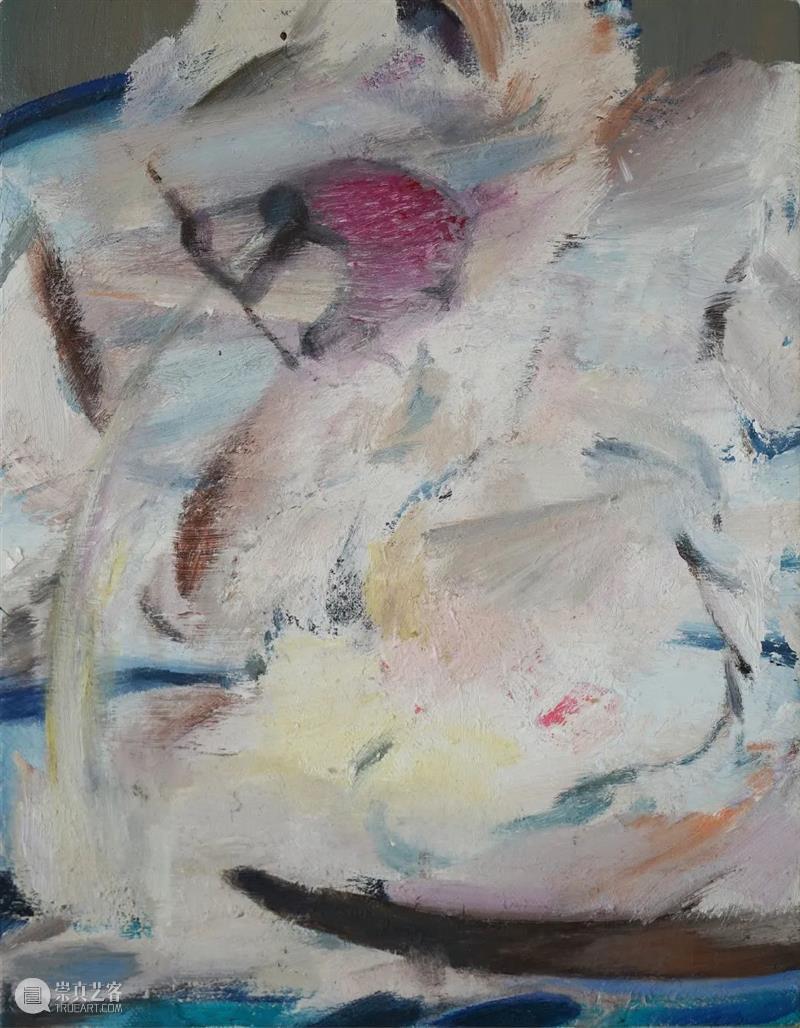
荒诞之海 桅杆之上Mast the Absurdities
布面油画Oil on Canvas, 30x40cm, 2019
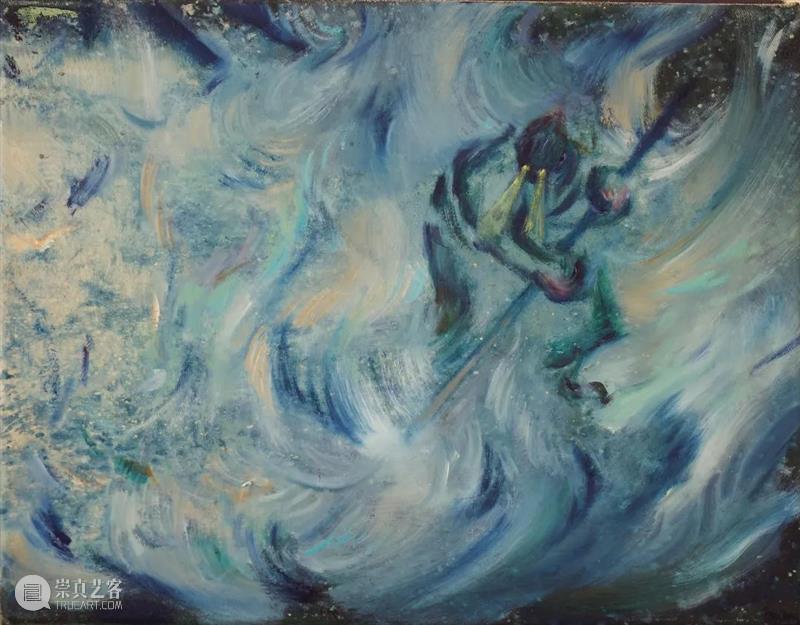
时节Solar Term
布面油画Oil on Canvas, 30x24cm, 2019
Behold, The fire!
— Discuss the turns in Zhang Bofu's painting language
By Yao Siqing
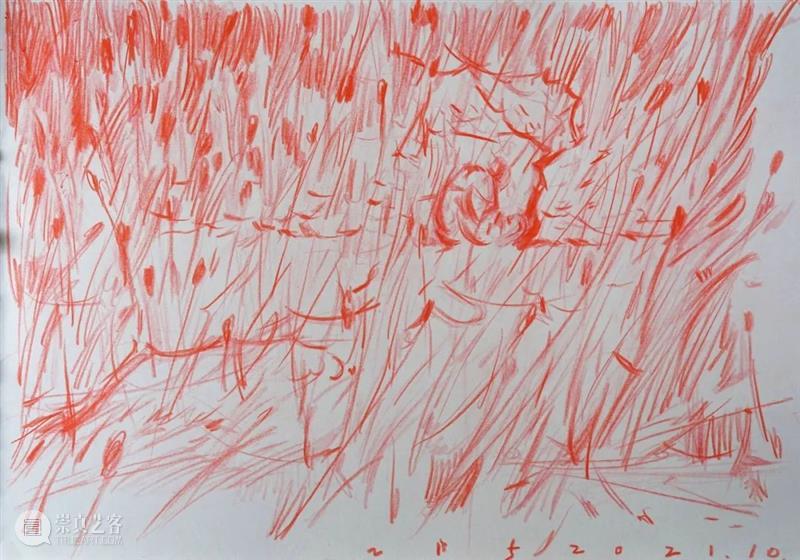
“祈求他的无限的恩泽,为我们挡住那万钧雷霆” Pray for his infinite grace,Stop the thunder for us,纸上红铅Red lead on paper,2021
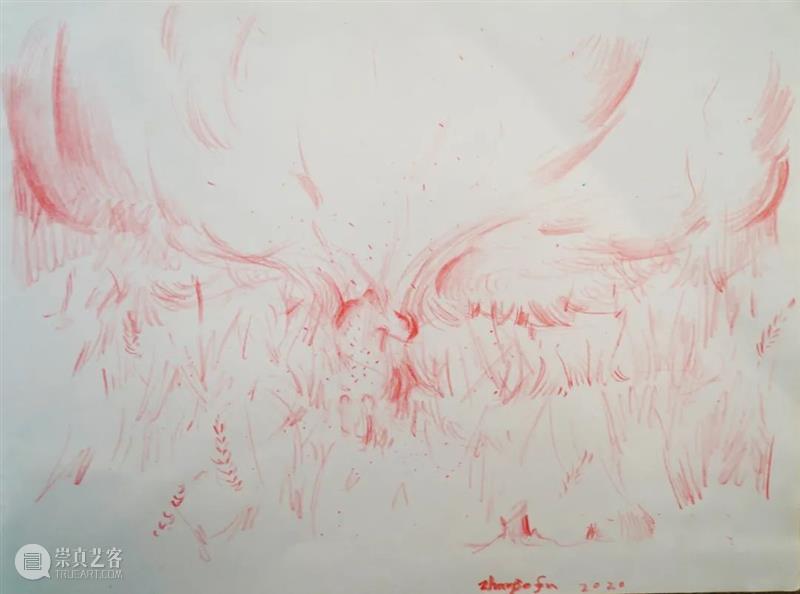
烬地Ember land
纸上红铅Red lead on paper,2021
The fire jumped out and became the main symbol in Zhang Bofu's paintings. This is undoubtedly not only a change in the content of the picture but also a change in the way of expression; it tends to be symbolic, which means that the artist is trying to speak to the audience in another language because of the previous grammar that deliberately avoided personality has failed. Painting fire has become an unavoidable inner need of Zhang Bofu. The fundamental reason is that the impact of death guides him to ask questions about the existence and value of life. Therefore, this series of recent works are also referred to by the artist himself as a more "returning" painting, which is what Levinas refers to as an experience of "being against death". However, this kind of personal experience-based interpretation cannot be fully answered. Why has the fire to be symbolic? Why is it not expressive or realistic? Is it rebelling against the past self or turning into it? Perhaps the clues to answer the question are still in the painting, which requires the viewer to further gaze at the fire.
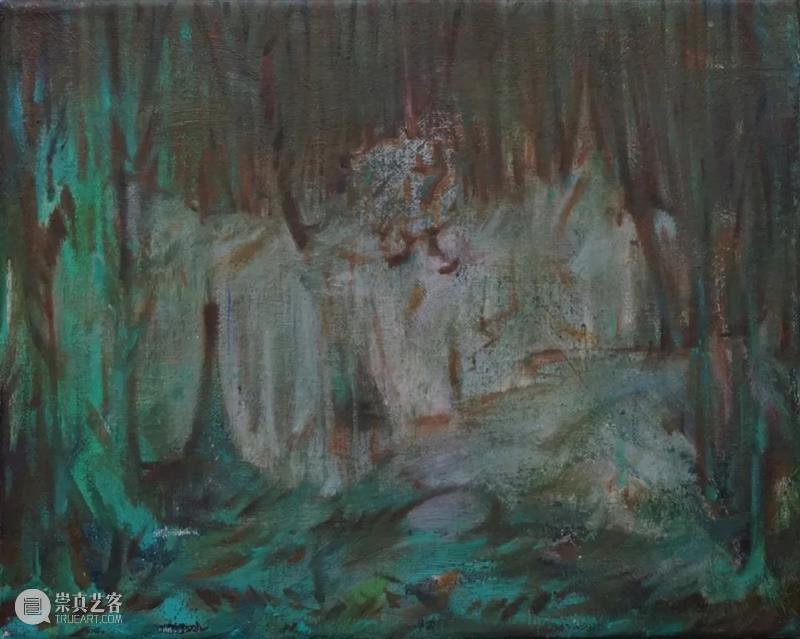
林中 In the woods
布面油画Oil on Canvas, 30x24cm, 2019
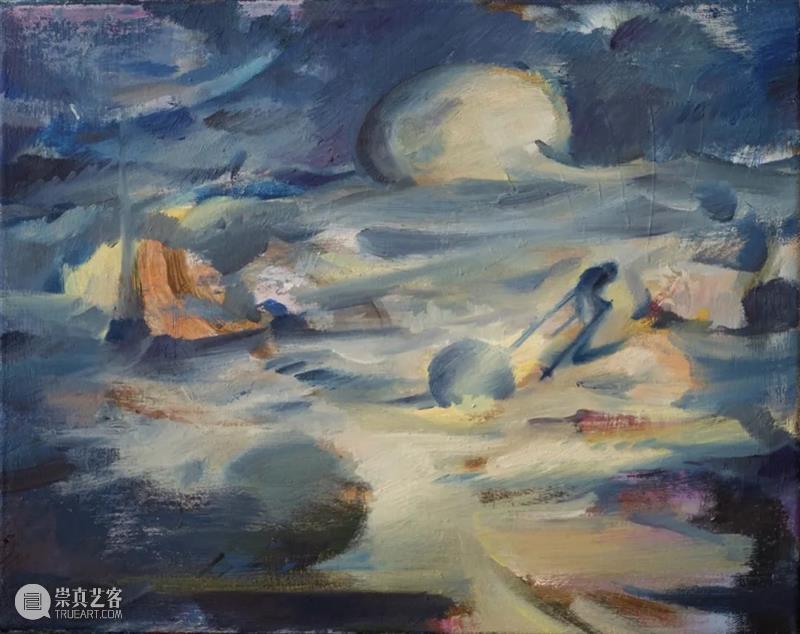
往复之路 Way of Samsara
布面油画Oil on Canvas,30x24cm, 2021
What kind of fire do we see in it? The man in suit and leather shoes named ‘The World', which head is fire and the face is hidden. This can vaguely see the shadow of Zhang Bofu's previous works — he is obsessed with drawing an anonymous, anti-portrait character spirit slicing, after erasing the traces of individualized experience, only the fuzzy positioning and established actions in the huge social collection are left, such as the artwork 'Shape Maker' who lost his head, and even worse, only left the blindly moving legs, such as the painting 'No Sheet for Padding'. In addition, there is a fire that cannot be extinguished on a rainy night. It spirals upwards, stubbornly pointing upwards, illuminating a small piece of ground in the foreground, but behind it is still a dark area, which is hidden by the curtain. The setting of this background makes it relevant to another painting ‘The Curtain’.
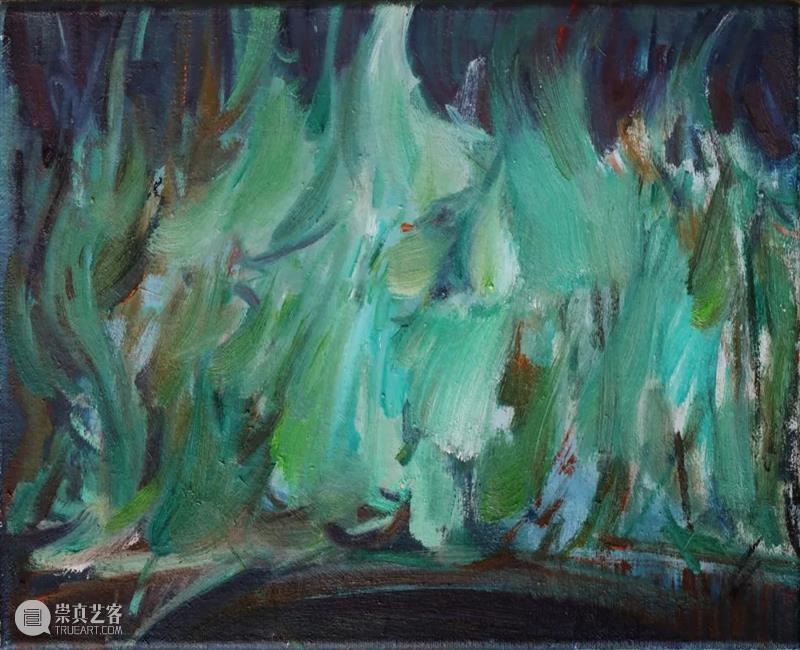
岸边 The Shore
布面油画Oil on Canvas, 30x24cm, 2020
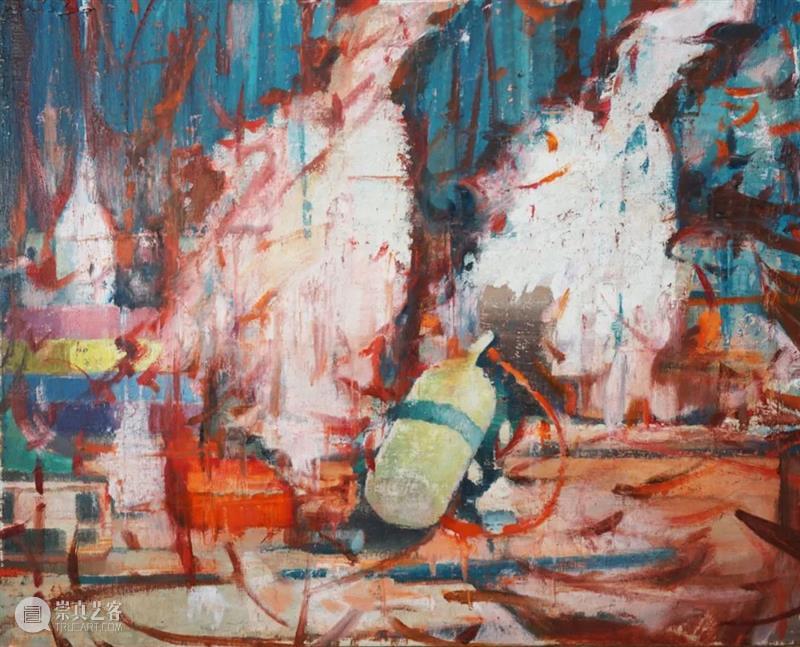
晚钟 Curfew
布面油画Oil on Canvas,50x60cm , 2021
The artwork 'The Curtain' is one of Zhang Bofu's most important works at this stage, and it also most comprehensively translates the artist's thoughts and feelings about life and the world. In this artwork, the fire burns on the stage, and even grows hard edges and corners. The curtain only slightly opens a gap, keeping the audience in front of the stage mysterious. The play has not yet been performed, that is, the stage and the daily life have not yet been connected, but the audience outside of the painting is placed in the background by the painter. Because of this special perspective, the privilege of spying ahead is given:before the birth of individual life, the impermanence encounters and self-awareness began, it was just a group of majestic flames. A burner in a green robe turned his back to us, holding a long stick to turn the fire so that its breath flowed and not extinguished... the curtain was about to be pulled open. When the artist intends to explain the prior knowledge of the origin of life through visual schema, it can only be presented as a symbolic means. In the painting, the solid and powerful shape of fire seems to further reflect the artist's desire not to be extinguished by the influence of the external environment, and at the same time carefully control the fire not to spread and cause harm. It must be noted that Zhang Bofu gave fire to these two characteristics are exactly the opposite of the fire of all experience. The fire of experience, which will inevitably disappear or spread with the passage of time, is excluded from the world in the painting; at this point, we have the first recollection of the gaze of the symbolic fire.
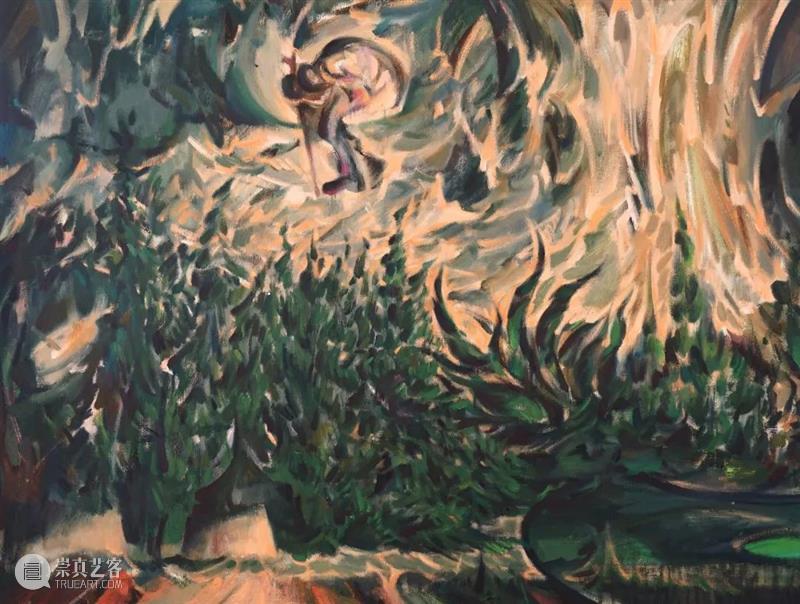
旅途 journey
布面油画Oil on Canvas, 80x60cm, 2021
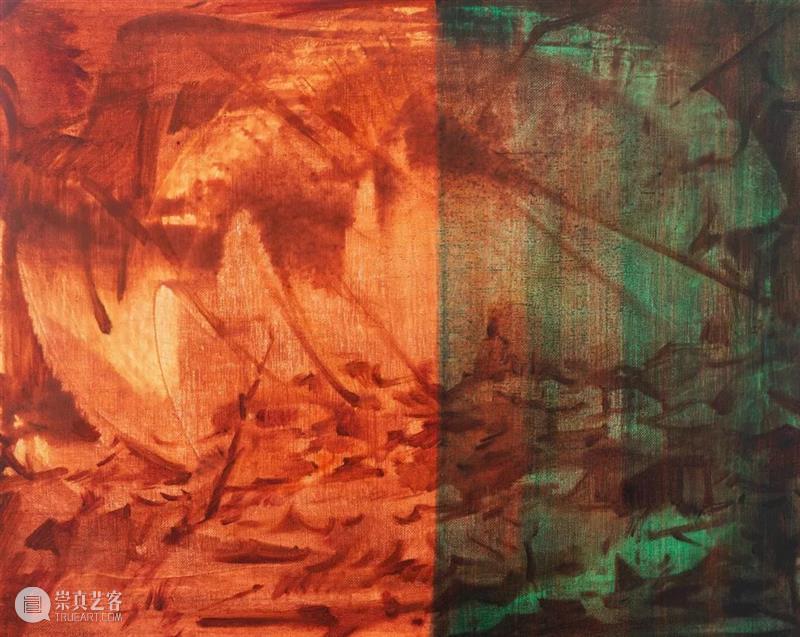
等待的维庸 pending Villon
布面油画Oil on Canvas,50x60cm, 2021
Symbolism, as a simplified schema of idealism, has a typical feature of looking for a world beyond natural time, which means making fire strong. Summoning all kinds of fire patterns that we know in history, the first thing that jumped out of our minds might be the fire that Heraclitus used as the origin of the world, the fire in the intergeneration and restraint of the five elements, the fire of Zoroastrianism... bonfires, torches, candlelight, everything the light of enlightenment that claims to dispel darkness and ignorance is reflected in the eyes of human civilization and is depicted as desirable and controllable. Symbolism rewrites the duality of fire and erases the violent Nero burning. Eliminating the positive moral connotations that give it, also makes its negative meanings cleaned and filtered into pure energy and vitality. As a result, fire can be placed in the position before the beginning of the world, as the basic element to support its operation. In Zhang Bofu's writings, the above-mentioned will to recode "fire" can also be found. The image of the fuel-supporter in the painting represents the care of fire as its origin. A focused human sight is personified. This is also existing in other pictures. In the expressions such as in the artworks 'Two Clusters', 'New Tree', 'Round Tree', 'Cliff Cypress' and 'Free Tree', he further emphasized his eagerness to conceal its brilliance by transforming the "fire" into a "tree" rooted on the earth. Until here, the fire described by Zhang Bofu has the second aftertaste.
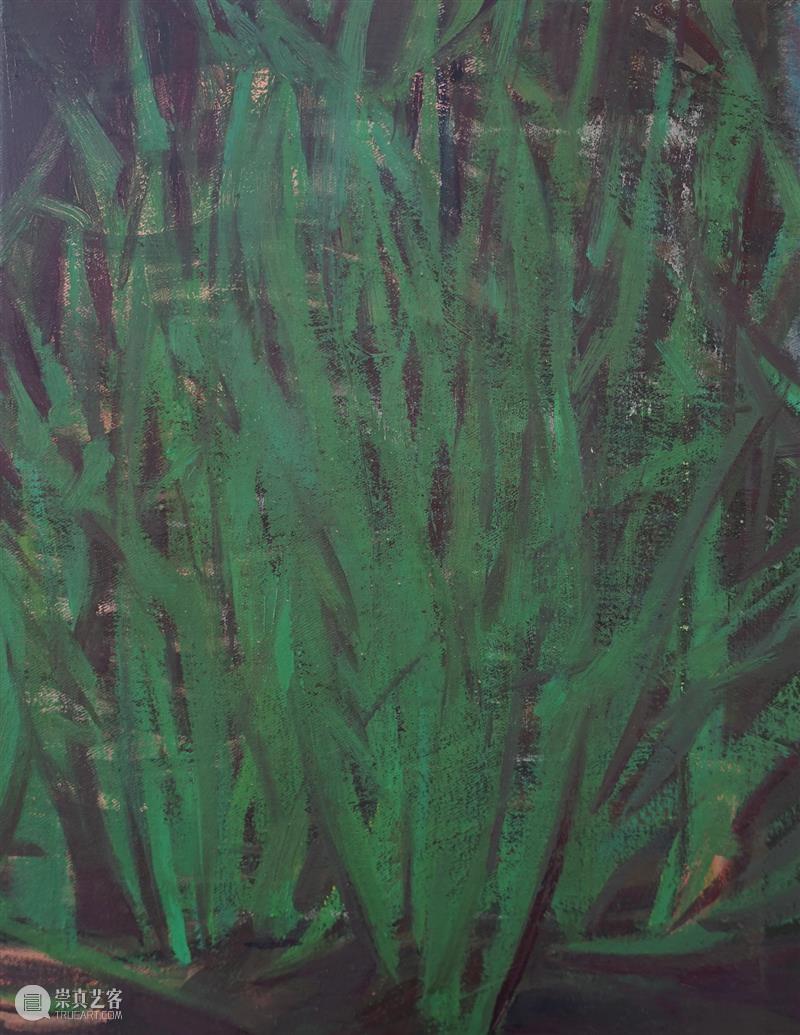
生草 blind weeds
布面油画Oil on Canvas, 30x24cm, 2021
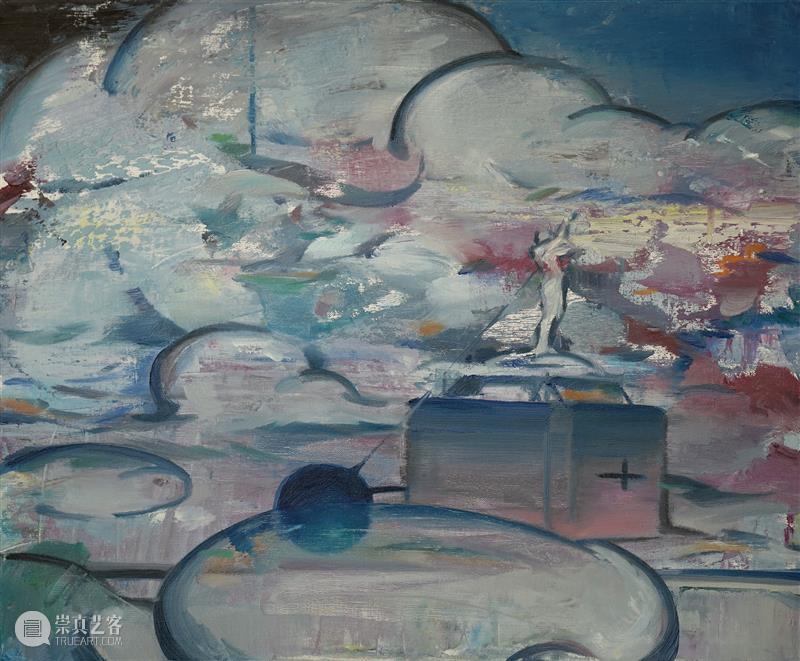
锚地 Anchore Place
布面油画Oil on Canvas,50x60cm, 2016
From the transformation of "fire" to "tree" and the transformation from "fire" to solid-state, "fire" has obtained an opportunity for continuous growth. At the same time, Zhang Bofu intends to infiltrate the transcendental primordial energy into the world of experience, thus revealing a sense of persistence for vitality. This separates the "curtain" with 'The Curtain' of the life of death and the pre-existence, which also can echo each other. In these paintings of trees, it is hard to guess whether Zhang Bofu’s memory of walking in the Black Forest in Germany is evoked, but the painting’s obsession with "life" does have a deeper relationship with his ideology: human death became the core of Zhang Bofu's lingering thinking during this period. Looking back at this shore from the edge of the other shore, the perplexity of "how to live" developed from the deadness of man was once a "big question" in classical philosophy. Plato's "Phaedo" is a famous text that explores this issue. Socrates, who believes that the soul is immortal and thus died in peace, demonstrated the tremendous tension of the duality of soul and body... However, in a more personal context, Zhang Bofu finally absorbed the Levinas-style “reverse” "dying and being", Levinas uses "enjoyment" to understand the relationship between individuals and others in life. In fact, in the shadow of death, he puts forward a positive ethical life aspect, and thus regards the survival of the individual as a series of reflexive rhythms. This clarification of this mental journey first helps us understand Zhang Bofu’s change in painting concepts: in the past, he regarded painting as acting without self-purpose, an objective existence that does not respond to the subject’s own needs, even he believes that the emphasis on individual experience is the lack of self-discipline in practical rationality; but this view has now been changed by the real demand of "being against death", which has changed the language of painting.
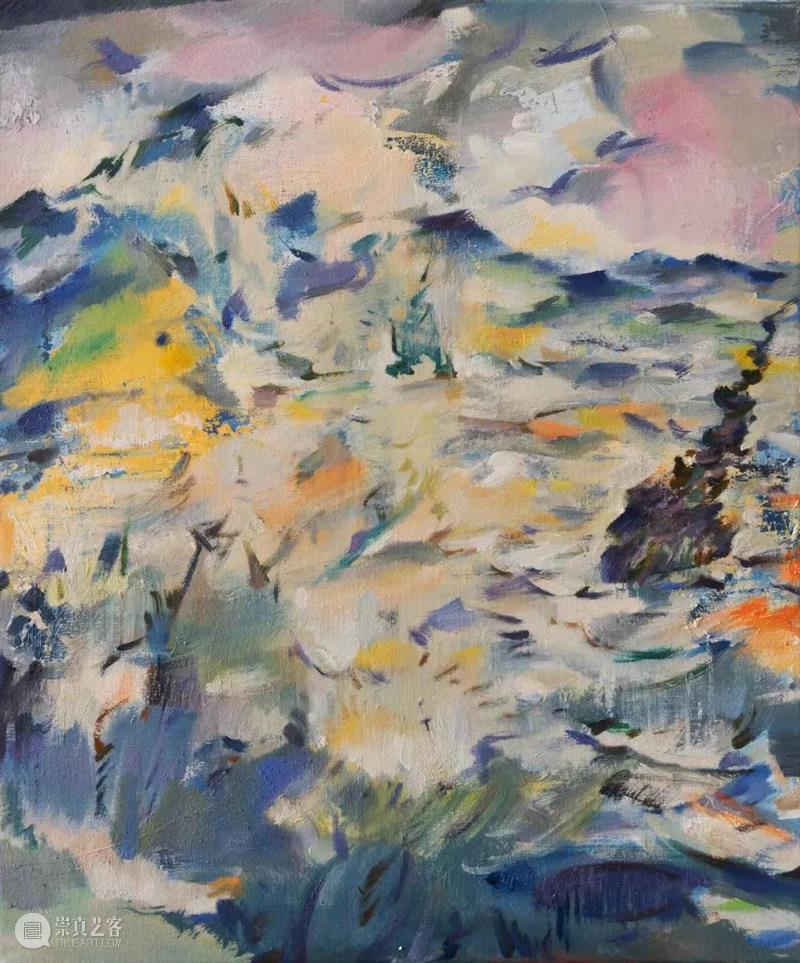
火湖 Lake of Fire
布面油画 Oil on Canvas,50x60cm,2021

家园 homestead
布面油画Oil on Canvas,80x60cm , 2021
This also forces us to further understand the existence of the "burner" in the painting, especially the ethical appeal it represents. In addition to the work 'The Curtain', the same character also appeared in the work 'Free Tree', and its image became more invisible, like a group of ghosts floating in the bushes, and the slender poker in his hand was also in a trance. It becomes the oar of the boat, and its function is more mixed and ambiguous between the combustion support and the borrowing force. It’s not hard to notice that in the artworks 'Mast the Absurdities' and 'Solar Term', this fuel-supporter is almost incarnate as a boat on the sea waves. The relationship between the person and the person is intertwined tensely here, not an absolute opposition, nor an absolute entanglement; but it is also in this way that the subject falls off a functional position, from the machine of the artwork ‘Shape Maker’ falling off from the action, falling off from the social web represented by the suit in the work 'The World', the experience of being able to speak of existence is constantly moving in the eternal tension of the impermanence of death and the struggle of life. Behold, the fire! In the variation of "fire" and "tree", Zhang Bofu gave us an opportunity to revisit the image of "fire"; and after several rounds, we finally discovered that this strange fuel-supporter in the fire, It is not so much that Zhang Bofu is attached to the vitality of fire and trees, but rather that he is obsessed with reshaping the ethical relationship between "I" and "fire" through the image of a fuel-supporter, which ultimately transcends the symbol of "fire" simple expression of schema. Perhaps, under Zhang Bofu's strong symbolic impulse this time, there is also the possibility of another turn of painting language.
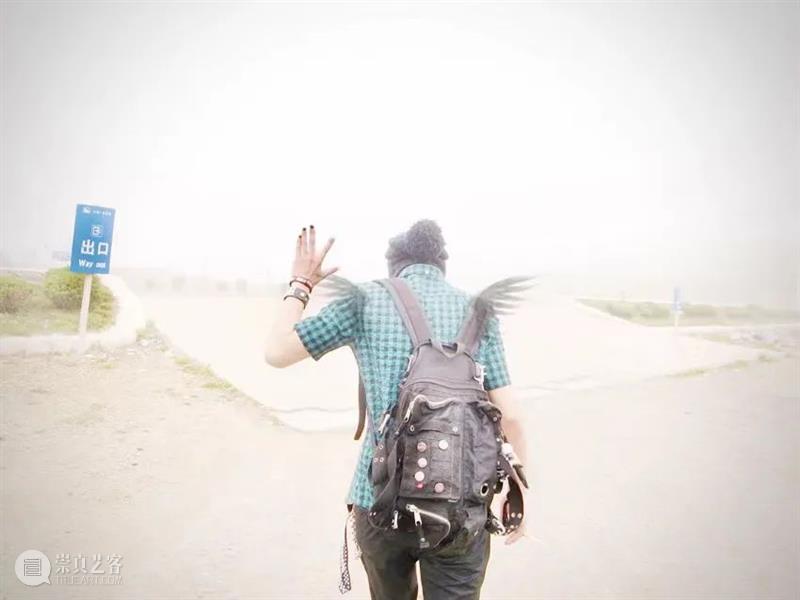
关于张博夫
2007 毕业于德国卡塞尔艺术学院自由艺术Prof.Kurt Haug 工作室,Meisterschüler。
2001-2007 Studium “Freie Kunst”bei prof.Kurt Haug an der Kunsthochschule Kassel Deutschland.Ernennung zum Meisterschüler.

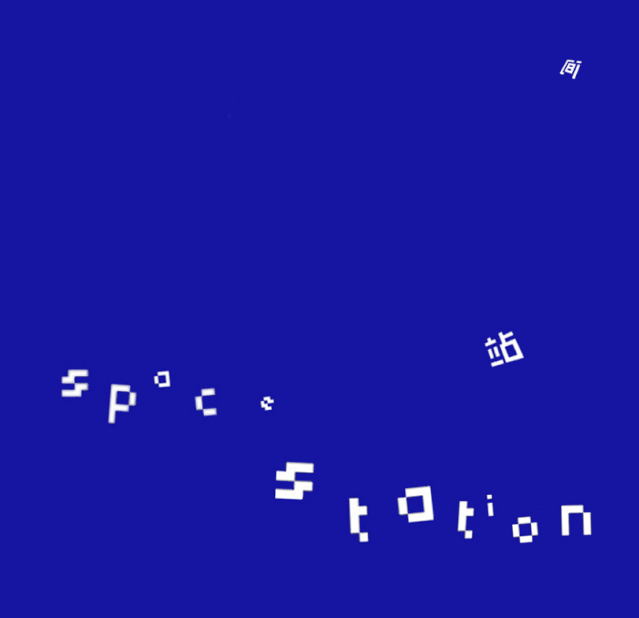


已展示全部
更多功能等你开启...





 分享
分享